Ganesh naik linux_kernel_internals
- 1. 1 Linux Kernel Internals - By Ganesh Naik Director – Levana Technologies Embedded Android & Linux Consultant and Trainer www.levanatech.com
- 2. 2 About Author of book : “Learning Linux Shell Scripting”, plublished by Packt Publication Website : https://www.packtpub.com/networking-and-servers/learning-linux-shell-scripting
- 3. 3 • Compiling & testing hello World – Preprocessing – Compilation – Assembling – Linking Understanding Hello World Program
- 5. 5 5 • Why do we need device drivers ? • Conceptual understanding of real world character device driver • User Space, Kernel Space & Hardware interaction Conceptual Understanding of Device Driver
- 6. 6 6 Application and device driver
- 7. 7 Memory-mapped device registers and I/O space ports Memory Register Device Register I/O Space Register CPULOAD/STORE IN/OUT
- 8. 8 • Device Registers: command, status and data buffer • Accessing device Registers: (i) address of the device’s first register (ii) address space where these registers live • I/O Space Registers: (i) inb() Read a single value from I/O Port (ii) outb() Write a single value to I/O Port • Memory-mapped registers: (i) readb() Read a single value from I/O register (ii) writeb() Write a single value to I/O register Memory-mapped device registers and I/O space ports
- 9. 9 9 There are three types of device driver Char (c) Block (b) Network Linux Treats every device as a file and to interface the driver uses device nodes found in /dev historically Network device driver unlike char, and block uses a different approach for the same CHAR DRIVERS
- 10. 1010 Kernel architecture System call interface Process management Memory management Filesystem support Device control Networking CPU support code Filesystem types Storage drivers Character device drivers Network device drivers CPU / MMU support code C library App1 App2 ... User space Kernel space Hardware CPU RAM Storage
- 11. 1111 Linux Kernel Generic Structure System Call Interface Process Management Memory Management Device Control File Management Network Management CPU MMU File Systems Block Devices (Disks,CDs) Character Devices (Keyboard, Monitor) Network Subsystem Network Card Concurrency VM, paging Handling Files tty access N/W Connectivity Features
- 12. 12 Memory Management - Introduction Memory management: one of the most important kernel subsystems Virtual Memory: Programmer need not to worry about the size of RAM (Large address space) static allocation: internal Fragmentation Dynamic allocation: External Fragmentation Avoid Fragmentation: Thrashing -overhead
- 13. 13 Memory mapping executable image spilt into equal sized small parts (normally a page size) virtual memory assigns virtual address to a each part linking of an executable image into a process virtual memory Swapping swap space is in hard disk partition if a page is waiting for certain event to occur, swap it. use physical memory space efficiently if there is no space in Physical memory, swap LRU pages into swap space
- 14. 14 Demand Paging Don't load all the pages of a process into memory Load only necessary pages initially if a required page is not found, generate page fault page fault handler brings the corresponding page into memory.
- 15. 15 A tour to a program execution Execute ./a.out Memory Mapping Demand paging LoadPage Table VPFN VPFN P R O C C E S S O R execute Virtual Memory Page Table Page Fault Swap Space Hard Disc Exit
- 16. 16 • Regular • Directory • Symbolic Link – Hard Link, Soft Link • Pseudo - /proc • Special files – Device drivers • Pipe - FIFO • Socket Everything in Linux is a file
- 17. 17 VFS
- 18. 18 When you create a file system, Linux creates a number of blocks on that device. – Boot Block – Super-block – I-node table – Data Blocks • Linux also creates an entry for the “/” (root) directory in the I-node table, and allocates data block to store the contents of the “/” directory. File Systems - Creating B S inode table Data blocks
- 19. 19 • The super-block contains info. such as: – a bitmap of blocks on the device, each bit specifies whether a block is free or in use. – the size of a data block – the count of entries in the I-node table – the date and time when the file system was last checked – the date and time when the file system was last backed up – Each device also contains more than one copy of the super-block. – Linux maintains multiple copies of super-block, as the super-block contains information that must be available to use the device. – If the original super-block is corrupted, an alternate super-block can be used to mount the file system. File Systems - Superblock
- 20. 20 • The I-node table contains an entry for each file stored in the file system. The total number of I-nodes in a file system determine the number of files that a file system can contain. • When a file system is created, the I-node for the root directory of the file system is automatically created. • Each I-node entry describes one file. File Systems – I-node table
- 21. 21 • Each I-node contains following info: – file owner UID and GID – file type and access permissions – date/time the file was created, last modified, last accessed – the size of the file – the number of hard links to the file – Each I-node entry can track a very large file File Systems – I-node table
- 22. 22 ext File System I-node I-node StructureI-node No ………. Block -1 Address Block -N Address ………. Single Indirect Block Address Double Indirect Block Address Triple Indirect Block Address N direct Block Address N single indirect Block Address N double indirect Block Address
- 23. 23 • A device special file describes following characteristics of a device – Device name – Device type (block device or character device) – Major device number (for example ‘2” for floppy, “3” for hard-disk ) – Minor device number (such as “1” for “hda1”) • Switch Table - Linux kernel maintains a set of tables using the major device numbers. • The switch table is used to find out which device driver should be invoked • For example : fd –> file table –> inode table –> switch table –> device drivers Device Special Files
- 24. Gnu compiler • A C source code should have a .c extension. • The command used to compile a C source code is gcc [options] <filename>.c • When a C source code is compiled, the compiler generates the executable. • By default, a.out ( the name of the executable) is generated, if no options are given to the compiler.
- 25. • size command $ size sample text data bss dec hex filename 968 260 12 1240 4d8 sample text executable code in bytes (in decimal format) data initialized data in bytes (in decimal format) bss uninitialized data in bytes (in decimal format) Total size of text, data, bss in decimal & hex notation
- 26. • readelf • readelf is useful to inspect an executable in a detailed way. • Use –d option to get the list of dynamic libraries an executable depends on $ readelf -d sample Dynamic segment at offset 0x4f4 contains 20 entries: Tag Type Name/Value 0x00000001 (NEEDED) Shared library: [libc.so.6] $ readelf -d /bin/ls Dynamic segment at offset 0x104d4 contains 22 entries: Tag Type Name/Value 0x00000001 (NEEDED) Shared library: [libacl.so.1] 0x00000001 (NEEDED) Shared library: [libtermcap.so.2] 0x00000001 (NEEDED) Shared library: [libc.so.6]
- 27. Memory layout of a C program Stack Heap Uninitialized data( bss) Initialized data Text High address Low address Command line args & environment variables Gets initialized to 0 at runtime Initialized global data Program code
- 28. 28 Parent process creates children processes, which, in turn create other processes, forming a tree of processes. Resource sharing – Parent and children share all resources. – Children share subset of parent’s resources. – Parent and child share no resources. Execution – Parent and children execute concurrently. – Parent waits until children terminate. Address space – Child duplicate of parent. – Child has a program loaded into it. Process Creation
- 29. 29 pid_t fork (void); creates a new process All statements after the fork() system call in a program are executed by two processes - the original process that used fork(), plus the new process that is created by fork( ) main ( ) { printf (“ Hello fork %dn, fork ( ) ”); } – Hello fork: 0 – Hello fork: x ( > 0); – Hello fork: -1 fork ( )
- 30. 30 if (!fork) { /* Child Code */ } else { /* parent code */ wait (0); /* or */ waitpid(pid, ….); } Parent and child
- 31. 31 To run a new program in a process, you use one of the “exec” family of calls (such as “execl”) and specify following: – the pathname of the program to run – the name of the program – each parameter to the program – (char *)0 or NULL as the last parameter to specify end of parameter list execl
- 32. 32 int execl (const char *path, const char *arg, …..); int execlp (const char *file, const char *arg); int execle (const char *path, const char *arg, ……., char *const envp[ ]); int execv (const char *path, char *const argv[ ]); int execvp (const char *file, char *const argv[ ]); All the above library functions call internally execve system call. int execve (const char *filename, char *const argv [ ] , char *const evnp [ ]); exec family
- 33. 33 An executable image Stack Heap Uninitialised data Initialized read-write data Initialized Read-only data Text $ size a.out (man size ) text data bss dec hex filename 920 268 24 1212 4bc a.out
- 34. 34 Very flexible and ease of use. Fastest IPC mechanisms shared memory is used to provide access to – Global variable – Shared libraries – Word processors – Multi-player gaming environment – Http daemons – Other programs written in languages like Perl, C etc., Shared Memory - Introduction
- 35. 35 Shared memory is a much faster method of communication than either semaphores or message queues. does not require an intermediate kernel buffer Using shared memory is quite easy. After a shared memory segment is set up, it is manipulated exactly like any other memory area. Why go for Shared Memory
- 36. 36 The steps involved are – Creating shared memory – Connecting to the memory & obtaining a pointer to the memory – Reading/Writing & changing access mode to the memory – Detaching from memory – Deleting the shared segment Steps to access Shared Memory
- 37. 37 used to attach the created shared memory segment onto a process address space. void *shmat(int shmid,void *shmaddr,int shmflg) Example: data=shmat(shmid,(void *)0,0); A pointer is returned on the successful execution of the system call and the process can read or write to the segment using the pointer. shmat
- 38. 38 Reading or writing to a shared memory is the easiest part. The data is written on to the shared memory as we do it with normal memory using the pointers Eg. Read: printf(“SHM contents : %s n”, data); Write: prinf(“”Enter a String : ”); scanf(“ %[^n]”,data); Reading/ writing to SM
- 39. 39 The detachment of an attached shared memory segment is done by shmdt to pass the address of the pointer as an argument. Syntax: int shmdt(void *shmaddr); To remove shared memory call: int shmctl(shmid,IPC_RMID,NULL); These functions return –1 on error and 0 on successful execution. Shmdt & shmctl



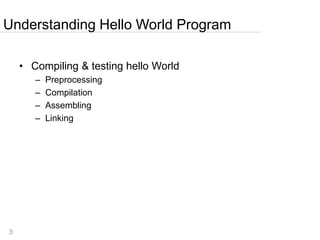
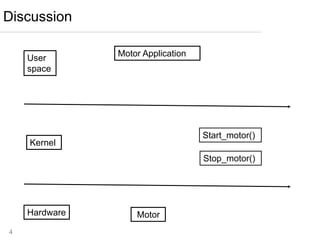
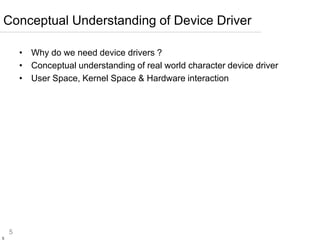


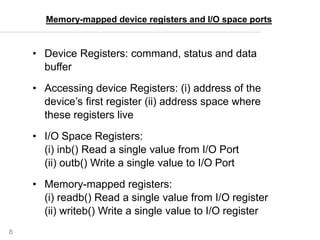















![Gnu compiler
• A C source code should have a .c extension.
• The command used to compile a C source code is
gcc [options] <filename>.c
• When a C source code is compiled, the compiler generates
the executable.
• By default, a.out ( the name of the executable) is generated,
if no options are given to the compiler.](https://image.slidesharecdn.com/ganeshnaiklinuxkernelinternals-160924184639/85/Ganesh-naik-linux_kernel_internals-24-320.jpg)

![• readelf
• readelf is useful to inspect an executable in a detailed way.
• Use –d option to get the list of dynamic libraries an executable depends
on
$ readelf -d sample
Dynamic segment at offset 0x4f4 contains 20 entries:
Tag Type Name/Value
0x00000001 (NEEDED) Shared library: [libc.so.6]
$ readelf -d /bin/ls
Dynamic segment at offset 0x104d4 contains 22 entries:
Tag Type Name/Value
0x00000001 (NEEDED) Shared library: [libacl.so.1]
0x00000001 (NEEDED) Shared library: [libtermcap.so.2]
0x00000001 (NEEDED) Shared library: [libc.so.6]](https://image.slidesharecdn.com/ganeshnaiklinuxkernelinternals-160924184639/85/Ganesh-naik-linux_kernel_internals-26-320.jpg)





![32
int execl (const char *path, const char *arg, …..);
int execlp (const char *file, const char *arg);
int execle (const char *path, const char *arg, ……., char *const envp[ ]);
int execv (const char *path, char *const argv[ ]);
int execvp (const char *file, char *const argv[ ]);
All the above library functions call internally execve system call.
int execve (const char *filename, char *const argv [ ] , char *const evnp [ ]);
exec family](https://image.slidesharecdn.com/ganeshnaiklinuxkernelinternals-160924184639/85/Ganesh-naik-linux_kernel_internals-32-320.jpg)



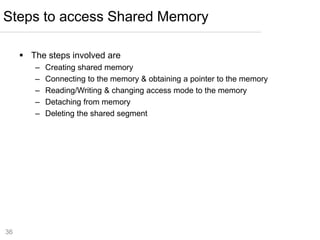

![38
Reading or writing to a shared memory is the easiest part.
The data is written on to the shared memory as we do it with normal
memory using the pointers
Eg. Read:
printf(“SHM contents : %s n”, data);
Write:
prinf(“”Enter a String : ”);
scanf(“ %[^n]”,data);
Reading/ writing to SM](https://image.slidesharecdn.com/ganeshnaiklinuxkernelinternals-160924184639/85/Ganesh-naik-linux_kernel_internals-38-320.jpg)

